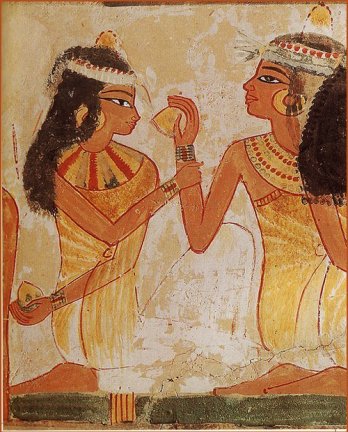The story of fragrances
and more precisely of perfume is inextricably linked to that of humanity.
Since the Antiquity,
Greeks and Egyptians burned plants and resins. The word “perfume” came from the
Latin word “per fumum” which means “by smoke”.
 |
| Picture of Egyptian women, 1300 BC - Afrique from http://www.egodesign.ca/fr/article_print.php?article_id=601 |
At times and according
the civilizations, perfume had different uses and so the techniques had
evolved. Indeed, the Romans were very ingenious in creating new fragrances that
they spread after on floors or walls, even on animals as horses or dogs.
Then, when the rise of
Christianity had stopped the use of perfume in the Middle East, the Arabs
preserved it and improved the distillation techniques thanks to the invention
of the still and the discovery of ethyl alcohol.
Contrary to common
beliefs, during the Middle Age, people are fond of washing and bathing. The
pomander, a sort of perfume holder, is one of the best accessories to preserve
musk, amber and perfumed oil.
 |
| Picture of a parcel-gilt silver pomander, 1550 from http://www.fragonard.com/parfums_grasse/FR/fragonard/histoire_du_parfum_et_fragonard/de_l_antiquite_au_moyen_age.cfm |
Modern perfumery began
in the late 19th century with the commercial synthesis of aroma compounds such
as vanillin or coumarin. It has to be a very luxurious good with the first
crystal bottles made by famous manufacturers such as Lalique or Baccarat.
François Coty is the
first perfumer to use synthetic scents. The Guerlain House launched its first
successful perfumes such as Shalimar since 1828.
In 1911, Paul Poiret
was the first to create a perfume as supplement to his fashion line. But Coco
Chanel made the difference in 1921 by launching Chanel n°5 with one of the
first commercials: an illustration of the designer herself.
Fashion and perfume
industries will keep very close ties since the industrialization and the
acceleration of trade and development of brands.
References:

No comments:
Post a Comment